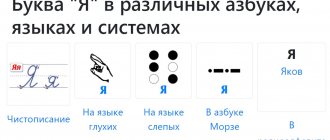Specifics of newspaper speech
The specificity of newspaper speech lies primarily in its special and intentional expressiveness and expressiveness of statements. Another stylistic feature of journalistic speech that is associated with expressiveness is the presence of a standard.
The newspaper is distinguished by the unique conditions of linguistic creativity. The newspaper is created in a short time, which often does not allow the processing of linguistic material to be perfect. And a newspaper is created not by one person, but by many journalists, who often prepare their materials in isolation from one another. The variety of newspaper genres, the publication on the pages of newspapers of orders, announcements, draft laws, orders, letters from readers leaves an imprint on the peculiarities of the language of the newspaper.
Are you an expert in this subject area? We invite you to become the author of the Directory Working Conditions
This determines the emergence of speech standards. Speech standards also appear for other reasons - due to a limited range of topics, due to the repetition of topics. One of the main reasons for the emergence of standards, and sometimes cliches, is the desire for expressiveness of expression. In the conditions of newspaper creativity, the search for ways of expressiveness causes the transition of expression into a standard. Therefore, in some cases, a positive desire turns into the opposite. But this does not mean the need to reduce the requirements for the expressiveness of newspaper and journalistic speech.
Note 1
V. G. Kostomarov defines the main stylistic principle of journalism as the unity of expression and standard, which constitutes the specificity of newspaper speech.
Newspaper-journalistic style as a functional style. Extraliterary vocabulary in the language of the media
The newspaper-journalistic style functions in the socio-political sphere and is used in oratory speeches, in various newspaper genres (editorial article, reportage), in journalistic articles in periodicals. It is implemented both in written and oral form. A characteristic feature of the newspaper-journalistic style is the combination of two trends - the tendency towards expressiveness and the tendency towards standard. This is due to the functions that journalism performs: informational and content function and the function of persuasion, emotional influence . They have a special character in a journalistic style. Information in this area of public activity is addressed to all native speakers and members of a given society (and not just specialists, as in the scientific field). For the relevance of information, the time factor is very important: information must be transmitted and become generally known in the shortest possible time, which is not at all important, for example, in an official business style. In the newspaper-journalistic style, persuasion is carried out through an emotional impact on the reader or listener. The author not only expresses his attitude to the information being reported, but also expresses the opinion of a certain social group of people - a party, a movement, etc. So, such a feature of the newspaper-journalistic style as its emotionally expressive nature is associated with the function of influencing the mass reader or listener, and the standard of this style is associated with the speed of transmission of socially significant information. The tendency towards a standard means the desire of journalism for rigor and information content, which are characteristic of scientific and official business styles. For example, standard expressions for newspaper-journalistic style include: steady growth, temporary support, wide scope, friendly atmosphere, official visit, etc.
The tendency towards expressiveness is expressed in the desire for accessibility and figurativeness of the form of expression, which is characteristic of artistic style and colloquial speech - features of these styles are intertwined in journalistic speech.
Here is a short fragment of the article: “In any society there are a number of problems directly related to the social functioning of women.
Feminism has long been preoccupied with these problems, insisting not on equality, but on the otherness of women and men. Education and medicine, the rights of children and the disabled, military service and the penal code - this is the field of social activity in which women's gentleness, the ability to compromise, and preference for the private over the public should have served their purpose. In essence, it doesn’t matter who combines all this into one program - a man or a woman. But it’s still more convenient for a woman. As my grandmother used to say, “Why talk to men - they don’t even know how to dress for the weather.” Here we use words and phrases characteristic of
the scientific style (a number of problems, the social functioning of women, preference for the private to the public, etc.)
,
official business style (the rights of children and the disabled, military service, regulations on punishment)
, as well as
colloquial , even colloquial expressions ( more handy, to do a service, as my grandmother used to say)
.
The newspaper-journalistic style is both conservative and flexible . On the one hand, journalistic speech contains a sufficient number of cliches, socio-political and other terms. On the other hand, the desire to convince readers requires ever new linguistic means to influence them. All the riches of artistic and colloquial speech serve precisely this purpose. The vocabulary of the newspaper-journalistic style has a pronounced emotional and expressive coloring, includes colloquial, colloquial and even slang elements, uses phrases that combine functional and expressive-evaluative connotations: duping, yellow press, accomplice, etc.
, which show belonging to the newspaper-journalistic style of speech and contain a negative assessment.
Many words acquire a newspaper-journalistic connotation if they are used in a figurative meaning. For example, the word signal has figurative meanings: it serves as an impetus for the start of some action - “This article served as a signal for discussion”
and a warning, a message about something undesirable that could happen -
“More than one signal has been received about an unfavorable situation on And that’s all But Soviet intellectuals continue to focus on youth.
There will appear, they believe, a new generation of Russian boys who will not want to put up with the meanness of their fathers .
The last phrase is precedent-setting, “Russian boys” by F.M. Dostoevsky was confronted with the world's unsolvable questions. Thus, the author of the article very expressively characterizes the type of “Soviet intellectual”, well-read, knowledgeable about Dostoevsky, striving to remake the world. The syntax of the newspaper-journalistic style of speech also has its own characteristics associated with the active use of emotionally and expressively colored constructions: exclamatory and interrogative sentences, sentences with address, rhetorical questions, repetitions, dismembered constructions, etc. The desire for expression determines the use of constructions with colloquial coloring: particles, interjections, inversions, non-union sentences, omission of one or another member of the sentence, etc.
The media have a thousand-year history, which dates back to the Roman plaster boards “Acta Senatus” and “Acta diurnal populi Romani”, placed in prominent places of the empire, ending with modern multi-million dollar publications of newspapers and magazines, the emergence of an increasing number of television channels and radio stations. At the dawn of its birth, journalism was of an elitist nature and was aimed at a highly educated reader - an intellectual. The development of computer technology and the advent of the Internet have had a tremendous impact on the development of society. With the development of information technology, traditional media have changed significantly. Modern media are aimed at both the intellectually developed reader and the mass reader. Thanks to these transformations, the stylistic features of the language and the thematic diversity of journalistic skills have expanded significantly. In addition to classical literary vocabulary, non-literary vocabulary also began to be used by authors of journalistic materials. Traditionally it is usually divided into:
Professionalisms and similar elements of non-spoken vocabulary can often be found in specialized publications aimed at improving the professional classification of workers.
Vulgarisms, such vocabulary was often used in the 90s of the 20th century, in connection with the reorientation of the press and the proclamation of “freedom of speech.” In author's materials, vulgarisms are extremely rare, most often for stylization, to characterize the literary portrait of the person depicted.
Jargonisms,
Slang.
The last two elements are worth taking a closer look at.
A modern journalist has a sufficient amount of knowledge in the culture of speech, which allows him to stylistically correctly format the text. For this purpose, media workers use all sorts of figurative language, the author’s position on a particular issue is quite clearly formulated, arguments are given, and an ethical or social assessment of a particular phenomenon is expressed. In a similar way, the language of the media is formed, designed equally for intellectual and mass readers. To enhance the impact on the audience, journalists resort to the use of graphic elements in print, such as photography, diagrams, cartoons and original drawings. Along with graphic elements, media workers also use elements of colloquial speech for the same purpose.
Newspaper text is very often built on the interaction of literary and non-literary vocabulary. In a similar way, you can achieve the effect of a negative or positive author’s assessment, the realism of the depicted phenomena, or convey the author’s irony, laughter, indignation, or sarcasm. Some scholars believe that the terms "slang" and "jargon" are unambiguous. Both of these definitions refer to social dialects, in other words, to the vocabulary of certain groups of people. Jargon is very often associated with professional vocabulary, which makes it similar to professionalisms (jargon of musicians, pilots, truck drivers); we can distinguish thieves', thieves' army jargon.
Slang consists of concepts and definitions that were originally used in narrow social groups. These words and statements are also of an emotional and evaluative nature. The most famous is youth slang, the scope of which is limited by age, social, time and space. The concept can be divided into three groups:
Computer slang is the language of programmers and Internet users and fans of virtual games (gamers),
Actually youth slang. This vocabulary is based on neologisms and incorporates the features of other social dialects,
Student slang. Vocabulary of students, both in general education institutions and students of universities and colleges. Most often, such vocabulary is based on abbreviations of the names of objects.
Modern journalistic cadres mostly consist of active young people belonging to the very narrow social group in which slang is widespread. These authors compile printed materials in which this vocabulary is used. This can be seen as a positive influence, since the modern press is interested in providing adequate information that is understandable to the majority of young people.
Journalists use jargon to establish contact with the audience and interest them in an unusual combination of words. Often jargon is included in the headline.
Words from slang are often used in programs aimed at young people; words from criminal or prison slang are used by journalists specializing in criminal topics.
The printed language is constantly evolving and improving. Literary language cannot quickly adapt to modern realities. Constantly changing reality forces the literary language to borrow certain concepts from slang and jargon. The characteristics of any object, phenomenon, or action can only be described using non-literary vocabulary. This kind of trend allows the Russian language to expand and develop.
Thus, the appearance of slang and jargon in the press is determined by a number of reasons, and is more positive than negative. Dialects of this kind are based on the national language and use its phonetic and grammatical framework.
Usage and Functions
This style is used when composing texts transmitted through the mass media. Journalistic texts can be found in newspapers and magazines, as well as in other periodicals. The subjects of journalistic texts can be various kinds of social, political or economic events, news or other information that concerns the general public and needs to be disseminated.
Examples of journalistic style of speech:
On September 14, the organizing committee approved the list of events dedicated to the 70th anniversary of the university. It was decided to hold a student conference, a festive concert and an award ceremony for students and teachers who actively participated in the life of the university.
The opening of the gallery of modern painting in the center of St. Petersburg was attended by guests and experts not only from other cities of the Russian Federation, but also from France, Italy and Japan. The director of the gallery said that exhibitions of young artists from Europe and Asia are planned in the future.
Lexical features of journalistic texts
The journalistic style is distinguished by the presence of words and combinations that are characterized by imagery and represent lexical clichés: radical transformations, radical reforms, etc.
The focus of journalistic texts on the reader and listener is the basis for the use of phrases in them that create a connection between the writer (or speaker) and the addressee to whom the information is transmitted: Dear reader... Dear viewers...
Depending on the specific topic, journalistic texts may contain military, sociological, economic or historical terms.
Genres of journalism
The genre diversity of journalistic speech style is due to the presence of different media. Articles and essays are most typical for printed publications; interviews are also often published. Radio and television broadcast reports, messages and dialogues in the form of interviews, conversations and debates. A special place in the genre system of journalistic style is occupied by advertising, which can be presented in the form of announcements or essays. A frequently used genre in journalism are slogans that have a propaganda purpose: Let's take care of our nature!







